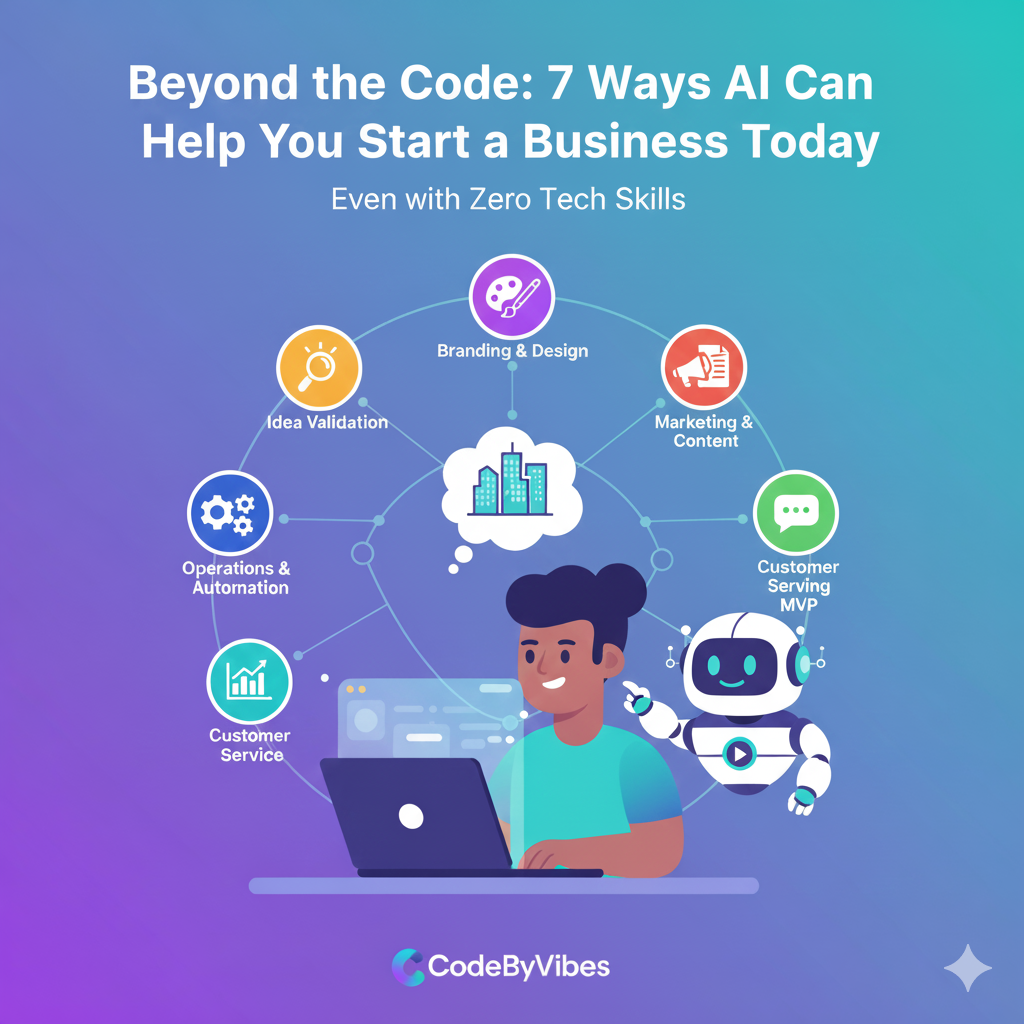Beyond the Code: 7 Ways AI Can Help You Start a Business Today (Even with Zero Tech Skills)
The Vibe Shift in Startups: The CTO is No Longer Required on Day One.
For years, the best ideas died because the founder didn’t know how to code. Launching a startup meant either spending a fortune on developers or struggling to find a technical co-founder. That era is over.
The Democratization of AI has fundamentally lowered the barrier to entry for entrepreneurship. The same conversational AI that powers Vibe Coding—the philosophy of building through natural language—is now your indispensable partner for every single step of your business journey. You don’t need to write a single line of code to get a viable business off the ground.
You just need a great idea and the right prompts.
Here are seven surprising ways AI can help you launch your business today, even if your technical skill is zero.
1. Idea Validation: Your Instant Market Researcher
Most startups fail because they solve a problem nobody has. Before spending a dime, you need to validate your idea. This used to cost weeks of time and expensive survey software. Now, you can use a simple prompt.
- The Old Way: Spend weeks compiling market reports and scrolling through forums.
- The AI Way: Use a generative AI tool (ChatGPT, Claude, Gemini) and prompt it like this: “Act as a market analyst. Analyze the discussion trends across Reddit and LinkedIn for [your industry/niche]. Is there a documented, unsolved need for a tool that does [your idea]? What is the competition?”
AI delivers the market viability research that used to require an analyst, confirming your idea addresses a real, documented need (Source: Buildpad/Medium, 2025).
2. Branding & Visual Identity: Your Design Agency in Minutes
A great brand requires a logo, a color palette, and high-quality hero images. Traditionally, you’d hire a graphic designer.
- The Old Way: Spend hundreds of dollars and days on revisions with a designer.
- The AI Way: Use a visual AI tool like DALL-E or Midjourney to generate assets. Prompt for a logo design, social media templates, or even product photography based on a simple description. You can also use AI features within Canva to instantly resize graphics and match your brand colors.
You are no longer limited by your own art skills; you are limited only by your ability to describe your vision.
3. Operations: Automate the Busywork That Kills Momentum
As a solo founder, you wear every hat—from sales to admin. AI takes the mundane work off your plate, freeing you up to focus on product and customers.
- The Old Way: Manually schedule follow-ups, input data into spreadsheets, and write endless internal reports.
- The AI Way: Use no-code automation platforms like Zapier or Make combined with conversational AI. You can automate lead capture, summarize meeting notes into action items, and draft personalized follow-up emails instantly. This frees up valuable time that can be reinvested in innovation (Source: Time Magazine, 2025).
4. Marketing: Generating Content that Actually Ranks
Marketing is often the toughest hurdle for non-technical founders. AI is your secret weapon for quickly creating large volumes of targeted content that attracts your first customers.
- The Old Way: Hire a copywriter and an SEO specialist.
- The AI Way: Use AI writing tools like Copy.ai or a sophisticated LLM to generate high-quality assets:
- SEO Blog Outlines: Ask the AI to draft an SEO-optimized blog post outline targeting a specific keyword.
- Ad Copy: Generate five versions of Facebook ad copy targeting different customer pain points.
- Email Templates: Use tools like Mailmodo’s AI to create customizable email marketing templates in minutes (Source: Mailmodo, 2025).
5. Customer Service: Your 24/7 Digital Assistant
Customers expect fast, 24/7 support. Setting up a dedicated customer service team is impossible for a bootstrapping startup—unless that team is AI-powered.
- The Old Way: You spend your evenings answering simple, repetitive FAQ emails.
- The AI Way: Deploy an AI Chatbot on your website using low-code platforms like MindStudio or Glide AI. These conversational agents can handle 80% of routine customer inquiries, triage complex issues, and work around the clock. This boosts satisfaction and builds loyalty, making you compete with much larger players (Source: Time Magazine, 2025).
6. Business Planning: Crafting a Strategy that Attracts Investors
A great idea is nothing without a structured plan. Generative AI excels at taking disparate ideas and organizing them into a coherent, professional document that can be used for internal strategy or investor pitches.
- The Old Way: Struggle for weeks formatting and structuring a complex business plan.
- The AI Way: Feed your AI co-founder all your research, target audience data, and revenue ideas. Ask it to synthesize this information into a “Detailed 10-page Business Plan following the Disciplined Entrepreneurship framework.” This rapid iteration allows you to try out more business models and commit to a stronger strategy much faster (Source: MIT Sloan Executive Education, 2025).
7. Execution: Building Your MVP with Vibe Coding
Once you have your idea validated, your brand defined, and your plan structured, the final step is building the Minimum Viable Product (MVP)—and this is where Vibe Coding shines for the non-coder.
- The Old Way: Learn Python, hire a freelancer, or try to duct-tape a clunky no-code tool.
- The Vibe Coding Way: Use modern AI App Builders like Base.44, Lovable, or Glide. You describe the app’s functionality in plain English—“Build a community forum where users can post tips and upvote their favorite submissions, connected to a simple user login.”—and the AI generates the functioning application with its database, authentication, and UI.
This process transforms you from an idea generator into an AI Translator—the person who can ask the right questions and command the tools to create solutions (Source: DEV Community, 2025). You focus on the why and the what; the AI handles the messy how.
The biggest barrier to starting a business is no longer technical skill, but the sheer inertia of getting started. With AI, that inertia is gone. The time to build is now.

